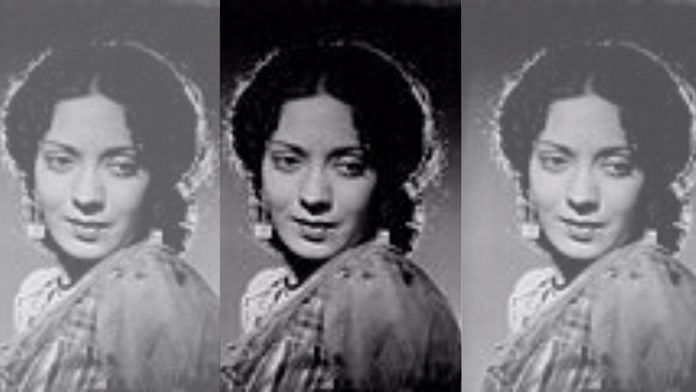Before Nirupa Roy and Lalita Pawar, actress Leela Chitnis embraced the long-suffering, self-sacrificing ‘elderly mother’ archetype in Indian cinema. Films such as Raj Kapoor’s Awaara (1951), Bimal Roy’s Maa (1952) or Dev Anand’s runaway hit Guide (1965) epitomise her role as Bollywood’s maternal figure.
Called ‘The Duchess of Depression’, her overarching image was of a mother who would “cough consumptively”, and “gobble spoonfuls of syrup from bottles perched so precariously on bedside tables that they overturned and crashed to the floor when there was no money to buy another,” R.M. Vijaykar wrote in a review of her work in 1997.
For Chitnis, films offered a means to support her children after a divorce. Born in Dharwad, Karnataka on 9 September, she entered the world of films when acting as a profession was looked down upon. As a divorced woman from a traditional Brahmin family—her father was an English professor—she was shunned for her career choice.
But Leela Chitnis did not let the labels determine her choices. “She was liberated before it was fashionable for Indian women to be liberated,” says Karan Bali in his luminary for her.
The actress is remembered for playing the woebegone mother to the then Bollywood biggies—Dilip Kumar and Dev Anand. As one of the first educated actresses to join the Hindi film industry, Chitnis played an important role in dismantling the irreverent image of film actors, particularly that of women, during the early 1930s. She also used her roles in films like Ganga Jamuna (1961) and Punar Janam (1964) to challenge the caste system.
Also read: Bhikaji Cama—Parsi revolutionary who plotted Savarkar’s escape, raised 1st Indian flag abroad
Her journey into Indian cinema
Married at the age of 15-16, she was divorced in her 30s and she worked as a teacher to support her children. Chitnis loved the stage and was part of the Marathi theatre group Natyamanwantar founded by director Keshav Narayan Kale and Marathi actor Keshavrao Date among others. She acted in their progressive plays, which were influenced by Norwegian playwrights Henrik Ibsen and George Bernard Shaw. She even founded her own theatre group Natyasadhana before gravitating toward Indian cinema.
She took on some rather unconventional roles before embracing motherhood on screen. Having started as an extra in the 1930s with Sagar Movietone productions, better known as Sagar Productions, she was soon working with major names like Master Vinayak in Chhaya (1936) and Sohrab Modi in Jailor (1938).
She wanted to join Bombay Talkies; a studio founded in 1929 that made actors like Ashok Kumar rise to fame. The film studio only hired graduates at the time so Chitnis went to Bombay University to pursue a degree. She was paired opposite Ashok Kumar in hits like Azad (1940), Bandhan (1940) and Jhoola (1941).
Her role as a polished male thief dressed in pants in Gentleman Daku (1937) led to her being featured in the Times of India as Bollywood’s first graduate society lady. By 1939, she was a major star.
All of these films broadly dealt with societal issues and catapulted Leela Chitnis to fame as Bombay Talkies’ premier star during the late 1930s. Her co-star Ashok Kumar admitted to learning the art of emoting through eyes from her.
Long before Aishwarya Rai Bachchan and Katrina Kaif became the face of Lux, Leela Chitnis was the first Indian actress to endorse the famous brand. Lux was earlier endorsed only by Hollywood actors.
Also read: Keshto Mukherjee, the comical drunkard of Hindi cinema who was a teetotaller in real life
Blockbuster heroine
Specialising in unconventional cinema that challenged societal norms like the caste system and marriage, the Bombay Talkies Studio in the 1930s was having a hard time at the box office. This was when it struck gold with Kangan, a 1939 film with Leela Chitnis in the lead playing an adopted daughter of a Hindu priest who stands up to her father for her love’s dignity. It was an unusual theme during those times for the public imagination. The film was under production during the Second World War and the film’s German director Franz Osten among others was detained as a prisoner of war. It was eventually completed by two of his assistants, as recollected by Kuldip Singh in Chitnis’ obituary for Independent. The film is often touted as the first Hindi blockbuster cinema.
Playing the Bollywood mother
By the middle of 1940s, her career as a leading lady was on the wane. Bollywood had gone back to typecasting actresses in conventional roles and Chitnis was unwilling to compromise. This is when she was cast as the hero Dilip Kumar’s ailing mother in Shaheed (1948)— a role she played to such perfection that for the next four decades she emerged as Bollywood’s best-known mother— an image she is remembered by, even now. In films Chhaya (1936), Insaaf (1937), Bandhan (1940), Awaara (1951), Naya Daur (1957), Kala Bazar (1960) and Waqt (1965), she was the afflicted mother struggling to raise her children.
In her later years, Chitnis started producing and directing a few films. She produced Kisise Na Kehna (1942) and also directed Aaj ki Baat (1955) starring her son Ajit Chitnis. She wrote and directed the stage adaptation of Somerset Maugham’s Sacred Flame (Ek Ratra Ardha Diwas (1957)).
In the 1970s she moved to the US to live with her children. There, she wrote her autobiography Chanderi Duniyet which was published in 1981. She describes the struggle to juggle family life and her career: The very path she chose to support her children, kept her away from them for extended periods.
At the age of 93, she passed away in Danbury, Connecticut, ironically in a much similar state as she was depicted in her movies—on a hospital bed.
(Edited by Ratan Priya)



